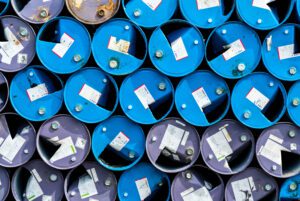In the process of manufacturing your products, you will almost certainly find yourself with waste to dispose. However, not all waste can be thrown out with the rest of the garbage. Hazardous waste like paint, waste solvents, mercury containing lamps, batteries, waste oils, and pesticides will need to be disposed of properly in order minimize its environmental impact.
If you have hazardous waste, there are rules set by the Environmental Protection Agency (EPA) that classify that waste and regulate its disposal. Here are the EPA regulations you need to know, including how to classify your waste and guidelines for how to dispose of hazardous waste at your workplace.
What is Solid Waste?
The EPA defines solid waste as “any garbage or refuse, sludge from a wastewater treatment plant, water supply treatment plant, or air pollution control facility and other discarded material, resulting from industrial, commercial, mining, and agricultural operations, and from community activities.”
The EPA further divides discarded materials into four categories:
- Abandoned
- Recycled
- Inherently Waste-Like
- Military Munition
There are a substantial number of exceptions to the solid waste definitions. Therefore, if you are unsure whether your company’s waste fits under the definition, contact a Tetra Tech expert for guidance.
Is Your Waste Hazardous?
There are two ways to determine if your waste is hazardous:
- Analytical testing
- Generator knowledge such as the chemical composition, production process, knowledge of by-products, etc.
Using data from analytical testing and/or generator knowledge, you must then confirm whether your waste exhibits any characteristics of hazardous waste.
The EPA has four categories of hazardous waste:
- Ignitable wastes can be either flammable or oxidizers.
- Corrosive wastes can be either acidic or alkaline.
- Reactive wastes can be dangerous by themselves but may also form dangerous secondary products when mixed with certain substances.
- Toxic wastes are substances that contain a constituent over a certain threshold. Some wastes may also be toxic just from the process in which they are involved.
Exceptions to Solid Waste Regulation
There are two common exceptions to the EPA’s Solid Waste Regulation: universal wastes and used oil.
- Universal wastes (40 CFR 273.9) include batteries, pesticides, mercury containing equipment, lamps, and aerosol cans. While these wastes are still hazardous, they generally do not have to be handled, transported, or reported like other hazardous wastes. However, there are different requirements for handling universal wastes depending on what type of waste it is and whether you are a small quantity handling or large quantity handler.
- Used oil (40 CFR 279) is another common exception that has its own set of rules that must be met. This includes regulations for oil storage, handling, and record-keeping.
While these are the most common exceptions to the EPA’s solid waste definition, they are not the only ones. There are also specific guidelines for pharmaceutical hazardous wastes, mixed radiological wastes, and academic laboratory wastes among others. If you are unsure about whether your waste qualifies, contact a Tetra Tech expert.
Keeping Track of Your Waste
As a waste generator, you need to keep track of your waste monthly. This is to ensure both the proper determination of your generator status and that your waste leaves your facility within the allotted time.
Your generator status is determined by how much hazardous waste you generate in a month. There are three generator statuses:
- Very small quantity generator.
- Small quantity generator.
- Large quantity generator.
Large quantity generators have the most rules to follow and the least amount of time to remove hazardous waste from their facility. Small quantity generators have more time to properly dispose of waste.
Universal waste and used oil do not count toward your generator status. However, they must be off your site within a year of generation.
All records on your waste need to be kept for at least three years.
It is also important to note that these are federal guidelines from the EPA; some states may have different rules regarding hazardous waste disposal.
Hazardous Waste Disposal in the Workplace
Small and large quantity generators must have an EPA identification number before they can dispose of hazardous waste. Very small quantity generators are not required to have an EPA identification number, but it is highly recommended that they do. You will also need to look up the guidelines for your specific state. Each state will have different requirements for very small generator status.
After obtaining your EPA identification number, your facility can dispose of hazardous waste. Your waste must be disposed of with a waste company that also has its EPA identification number.
As with every consumer transaction, there is a receipt. When handing your hazardous waste over to the waste hauler or waste management company, you will need to correctly fill out a manifest that is signed by both your company and the company receiving your waste. You will get an initial copy of the manifest when your waste is taken by the waste company. Once the waste has been properly disposed of, your facility will receive a second copy of the manifest. Your facility will need to keep these records for a minimum of three years.
Get Support From Tetra Tech
Understanding your hazardous waste generator status and the regulations you must meet is crucial when it comes to handling your solid waste properly. If need help determining your status or have any questions related to waste, let us know. We can walk you through your hazardous waste requirements and help you understand how to properly dispose of your waste.






